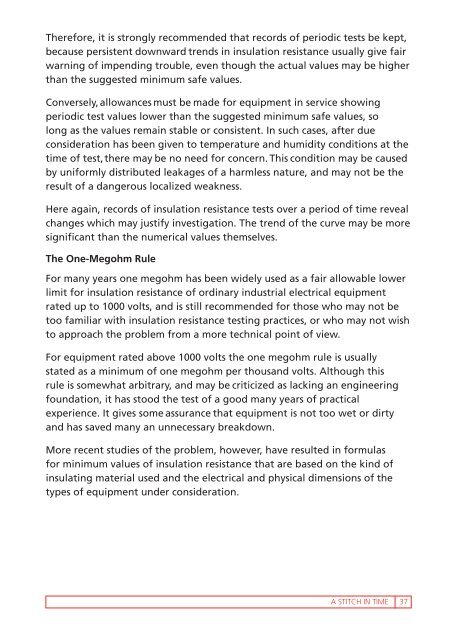“A Stitch in Time...”
Create successful ePaper yourself
Turn your PDF publications into a flip-book with our unique Google optimized e-Paper software.
Therefore, it is strongly recommended that records of periodic tests be kept,<br />
because persistent downward trends <strong>in</strong> <strong>in</strong>sulation resistance usually give fair<br />
warn<strong>in</strong>g of impend<strong>in</strong>g trouble, even though the actual values may be higher<br />
than the suggested m<strong>in</strong>imum safe values.<br />
Conversely, allowances must be made for equipment <strong>in</strong> service show<strong>in</strong>g<br />
periodic test values lower than the suggested m<strong>in</strong>imum safe values, so<br />
long as the values rema<strong>in</strong> stable or consistent. In such cases, after due<br />
consideration has been given to temperature and humidity conditions at the<br />
time of test, there may be no need for concern. This condition may be caused<br />
by uniformly distributed leakages of a harmless nature, and may not be the<br />
result of a dangerous localized weakness.<br />
Here aga<strong>in</strong>, records of <strong>in</strong>sulation resistance tests over a period of time reveal<br />
changes which may justify <strong>in</strong>vestigation. The trend of the curve may be more<br />
significant than the numerical values themselves.<br />
The One-Megohm Rule<br />
For many years one megohm has been widely used as a fair allowable lower<br />
limit for <strong>in</strong>sulation resistance of ord<strong>in</strong>ary <strong>in</strong>dustrial electrical equipment<br />
rated up to 1000 volts, and is still recommended for those who may not be<br />
too familiar with <strong>in</strong>sulation resistance test<strong>in</strong>g practices, or who may not wish<br />
to approach the problem from a more technical po<strong>in</strong>t of view.<br />
For equipment rated above 1000 volts the one megohm rule is usually<br />
stated as a m<strong>in</strong>imum of one megohm per thousand volts. Although this<br />
rule is somewhat arbitrary, and may be criticized as lack<strong>in</strong>g an eng<strong>in</strong>eer<strong>in</strong>g<br />
foundation, it has stood the test of a good many years of practical<br />
experience. It gives some assurance that equipment is not too wet or dirty<br />
and has saved many an unnecessary breakdown.<br />
More recent studies of the problem, however, have resulted <strong>in</strong> formulas<br />
for m<strong>in</strong>imum values of <strong>in</strong>sulation resistance that are based on the k<strong>in</strong>d of<br />
<strong>in</strong>sulat<strong>in</strong>g material used and the electrical and physical dimensions of the<br />
types of equipment under consideration.<br />
A STITCH IN TIME 37



